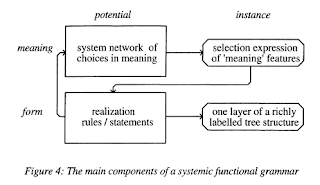Fawcett (2010: 113-4):
Halliday's introductory writings often imply that each line of structure corresponds to one of his three (or four) 'metafunctions', i.e., broad types of 'meaning'. There are four such metafunctions when he splits the 'ideational' metafunction into the 'experiential' and the 'logical', e.g., as described in Halliday (1977/78:128), but in his introductory writings he frequently omits the 'logical' and only illustrates three (as in Figure 7). The interesting point here, then, is that the four 'strands of meaning' shown in Figure 7 — and in all equivalent representations in IFG — do not correspond to Halliday's four 'metafunctions'. Thus the THEME and INFORMATION lines of analysis both belong in his 'textual' metafunction; the MOOD analysis (which itself contains two lines) is the 'interpersonal' metafunction; and the TRANSITIVITY is 'experiential'. The fourth 'metafunction' (i.e., the 'logical') is omitted in Figure 7, because Halliday only introduces it when there is a 'logico-semantic relationship' between two or more clauses.
Blogger Comments:
[1] This is misleading. Halliday explicitly states — over and over, across many publications — that each line of structure corresponds to the meanings of a separate metafunction. For example, Halliday (1994: 35):
[2] To be clear, the logical metafunction is concerned with relations between units in complexes all along the rank scale, whether clauses in clause complexes, groups or phrases in group or phrase complexes, words in word complexes, or morphemes in morpheme complexes.
[3] This is misleading. To be clear, Fawcett's Figure 7 illustrates only three metafunctional strands of meaning: textual, interpersonal and experiential, and misrepresents information as a structure of the clause (instead of the information unit). Reminder:
[4] This is misleading. To be clear, there are no representations in IFG that are equivalent to Fawcett's Figure 7; that is, there are no representations showing all three lines of clause structure in one diagram, though there are several that show both MOOD and TRANSITIVITY. The nearest equivalents appear in Appendix 1, an analysis of the 'Silver' text, but these are not confined to clause structure, and additionally demonstrate both cohesion and information analyses, neither of which constitutes clause structure, as well as the analysis of grammatical metaphor. For example, Halliday (1994: 371):
Clearly, Fawcett confuses this series of composite 'text analysis' diagrams in IFG with diagrams merely illustrating clause structure.
[5] This is misleading. Mood structure represents only one line of meaning, interpersonal meaning, but the structure itself involves functional constituency. For example, the Mood block of finite clauses consists of the Subject and Finite elements (± modal Adjuncts), and the Residue can consist of the elements Predicator, Complement(s) and circumstantial Adjunct(s).









